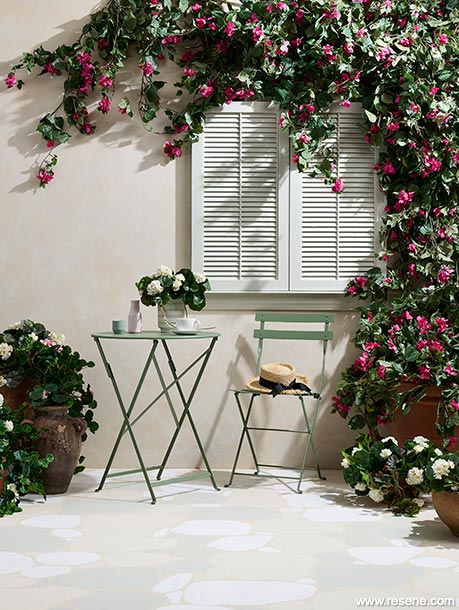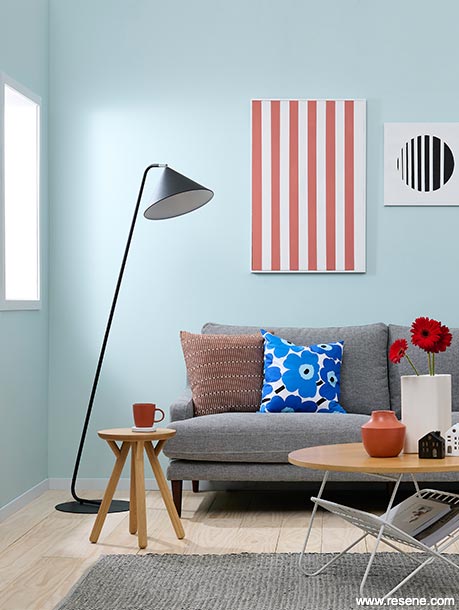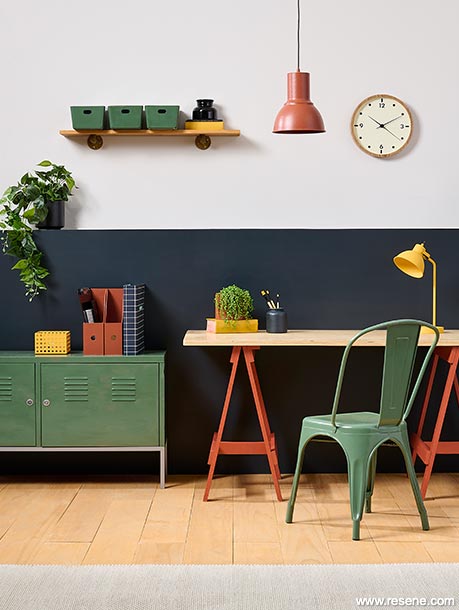From habitat magazine - issue 35, timeless style
As Resene celebrates 75 years of creating colourful homes, we explore five interior design styles that have stood the test of time.
Fashions come and go, but good style is constant. There are reasons why different décors have been more popular through the decades and why the impractical carpeted bathrooms of the 1970s or waterbeds of the 1980s died quick deaths. Like no other design field, interior design is linked to our personalities and the practicalities of our daily lives. In the same way that a work of art can evoke feelings and emotions, the colour and form of our homes create a mood. But the spaces must also be functional.
When Eastbourne builder Ted Nightingale founded Resene in 1946, local architects such as Cedric Firth were embracing the new modernist style. Mid-century modernism continues to be popular today. The reason for its resilience? Its cool and comforting décor is pleasant and practical to live in.
Ted passed Resene down to his son Tony in 1972. Tony, in turn, passed the business on to his son Nick, who continues to run the company today. It’s fair to say that since 1946, Resene has seen it all when it comes to design.
As Resene celebrates its 75th birthday, we look at classic interior styles that never go out of fashion.
We do like to be beside the seaside in the Antipodes. No matter where you are in New Zealand, you are never more than 225km from the ocean. In Australia, 85 per cent of the population lives within 50km of the coast. Kiwis and Aussies love the sea, the beach, our kaimoana and our coastal homes. While the most iconic coastal interior style comes from the Hamptons in New York’s Long Island, in this part of the world, we’ve put our own unique spin on this classic coastal style.

Hamptons room*
Our take on beachside living is often more family focused and much more relaxed than our American counterparts. To emulate the Hamptons look, start with white walls using a crisp grey-edged white such as Resene Black White or Resene Alabaster. Alternatively, create a salt-licked look using Resene Colorwood Whitewash.
Add blue accents – furniture, vases and DIY artwork can all be painted in navy shades, including Resene Blue Night or Resene Biscay. Or try layering with lighter blues, such as Resene Halcyon (inspired by the colour of sea foam) and a softer white like green-edged Resene Merino.
“The Hamptons style is an easy one to get right if you just stick to a simple palette of three main colours,” says interior designer Vanessa Nouwens.
Anchor the look with flooring stained in chocolate brown using Resene Colorwood Bark, protected by Resene Qristal ClearFloor.
In kitchens, white Shaker-style cabinetry with bevelled edges and shell handles exemplifies the Hamptons look, and few homes are complete without a barbecue area. Many coastal homes have weatherboard cladding, which is a gentle nod to the ribbing of a ship. Create indoor/outdoor flow by continuing the horizontal lines indoors with tongue-and-groove panelling or by screwing battens into the wall.
“Texture is key in a white space. Keep this in mind, so you don’t make the space look flat,” says Vanessa. “Add texture through details on the wall or via accessories such as coral and shells.”
To give the wall extra depth, paint the wall and battens in different sheen levels. Use Resene SpaceCote Low Sheen on the back wall and paint the battens with gloss Resene Enamacryl, which can also be used on trims and skirting boards.
* The tonal blues and whites of this Hamptons room create a relaxed, coastal vibe. Wall, small coral and seashell in Resene Black White, coffee table and Mocka cabinet in Resene Merino. Coral DIY artwork in Resene Blue Night and Resene Merino. Large coral in Resene Halcyon and vases and other accessories in Resene Blue Night, Resene Biscay, Resene Halcyon, Resene Black White and Resene Merino. Couch, navy cushion and bowl from Freedom, white cushion from Bed Bath & Beyond, linen-look blue cushion from The Warehouse, rug, lamp, ginger jars, coffee table book and geometric cushion from The French Villa. Team with a floor stained in Resene Colorwood Bark.
A trip to Tuscany or Provence might be once in a lifetime, but you can make every day a European escape by creating a courtyard with Mediterranean touches. This classic look never feels dated and is particularly charming for outdoor areas on villas, bungalows and Queenslanders. Though the key element to this look is limestone, uncommon in this part of the world, it’s easy to emulate the stone’s smooth edges and irregular finish using Resene FX Paint Effects Medium.

Mediterranean look*
“I used Resene Canterbury Clay in two strengths – half and eighth – as well as Resene Double Spanish White to help create a feeling of earthy Mediterranean warmth,” says interior designer Annick Larkin.
“The Resene FX Paint Effects Medium allowed me to create the illusion of a beautiful stucco wall. It’s much easier to do than it looks,” she adds.
For new builds, consider a plaster façade using INTEGRA lightweight concrete cladding with Ezytex Adobe plaster finish from Resene Construction Systems, which can be painted in any Resene colour.
Traditional shutters give your home’s exterior old-world charm. These can be painted in contrasting colours, such as a fresh blue like Resene Fountain Blue. Alternatively, for a more subtle palette, choose a soft beige such as Resene Kangaroo. Cobbles and terrazzo underfoot give the space a hand-crafted artisanal look, and natural stones are easily mimicked using Resene Walk-On paving paint. Pergolas, painted in an offwhite such as Resene Kangaroo, are a classic feature of Italianate gardens which link indoor and outdoor areas. These structures are ideal for al fresco dining and provide a frame for climbing plants such as grapevines, jasmine or bougainvillea (watch the thorns).
* Create the illusion of limestone walls using Resene FX Paint Effects Medium with layers of Resene Half Canterbury Clay, Resene Eighth Canterbury Clay and Resene Double Spanish White. The shutters and windowsill are Resene Kangaroo and the faux cobbled patio is painted in Resene Half Canterbury Clay, Resene Eighth Canterbury Clay, Resene Double Spanish White, Resene Blanc and Resene Half Spanish White. Vases in Resene Soothe, Resene Pewter and Resene Alabaster. Large amphora in Resene FX Faux Rust Effect. Table and chair from Jardin, coffee cup and hat stylist’s own.
The popularity of the pared-back aesthetic of Scandinavian design, which burst onto the interior scene in the early 2000s, shows no sign of waning. The clean lines, fresh colours and minimalism are comforting in an increasingly digitised and complicated world. However, in some ways, Nordic design has become a victim of its own simplified narrative. Scandinavian design is often reduced to a beautiful but basic look of white or whitewashed walls and blonded wood (to see a whitewashed Scandi bedroom, see page 6). In fact, there’s a lot more colour and flair to this style than your Pinterest, Instagram or Facebook feed might suggest.

Scandi and new Nordic look*
“Real Scandinavian homes are generally a far cry from the stark, white-on-white interiors that seem to have become synonymous with the style,” says Canadian-born interior designer and BlackWhite editor Laura Lynn Johnston. “When you grow up in a frigid northern climate and are surrounded by glaring white snow six to eight months of the year (which was also the case for most of my life – so I’m speaking from experience here), you need to have some cheerful colour in your home to keep yourself from going mad. To me, Scandi design has a confidence and fearlessness to it in terms of colour use and the mixing of patterns.”
The Scandinavian countries – Denmark, Sweden and Norway (often also grouped with neighbouring Nordic countries Finland, Iceland and Greenland) have a proud graphic and fabric design tradition. For instance, Finnish homeware company Marimekko, famed for its bold signature flower prints, has been around since 1951. Many famous mid-century furniture designers such as Alvar Aalto and Hans Wegner, whose Wishbone chair has been in production since 1950, hail from Nordic countries too.
Stockholm, the Nordic region’s sunniest capital, has 1800 hours of sunlight a year compared with Wellington’s 2110 and Sydney’s 2592. Bright whites, such as Resene Alabaster and Resene Black White, are good choices to reflect light in dark spaces. Other Scandinavian colour choices are fresh and nature inspired, such as pale blues like Resene Jet Stream and Resene Quarter Duck Egg Blue, sage greens like Resene Tasman and soft petal pinks like Resene Vanilla Ice.
“In the northern hemisphere, the ambient light is quite yellow, and the light is far bluer in New Zealand and Australia. In northern countries, people often choose colours that have warmer yellow or green undertones. Resene Jet Stream has those characteristics, so it’s a very authentic choice to use as a base to build a Scandi colour scheme from,” says Laura Lynn.
She adds that the stand out favourite accent colour in Scandi design is a vibrant blue, such as Resene Half Resolution Blue, which stands out brilliantly against white and light interiors.
Top tip: To create this Gordon Walters-inspired mural, make a cardboard template using a plate to fashion the curved edge. Paint the pattern in different colours but keep the look organic and casual by switching up the lengths of the korus.
* This colourful room with walls in Resene Jet Stream proves Scandi style is more than white walls and wooden furniture. Floor in Resene Colorwood Whitewash, trims and skirting in Resene Quarter Duck Egg Blue, striped DIY artwork in Resene Tuscany and Resene Half Black White and circular DIY artwork in Resene Nero and Resene Half Black White. Coffee table in Resene Colorwood Natural and Resene Aquaclear satin (top) with legs painted in Resene Enamacryl tinted to Resene Half Black White. Coaster in Resene Quarter Duck Egg Blue, mug in Resene Hot August, vases and ornaments in Resene Half Black White, Resene Tuscany and Resene Nero. Marimekko cushion from Bolt of Cloth, lumbar cushion from Città, brown cushion, lamp and stool from Freedom.
Mid-century modern was at its height between 1930 and 1965, but the inherently chic quality of this interior style means it has never gone out of fashion. Mid-century modern style is the inspiration behind the Karen Walker Paints collection from Resene. This colour chart is inspired by the modernist Bauhaus School, founded in Germany in the 1920s, whose concept was to create and combine colours from an emotional point of view.

Mid-Century modern
To recreate this style, start by decorating a room around statement pieces. The striking graphic mural wall of our room is inspired by the iconic Koru art series by modernist artist Gordon Walters and is painted in Resene Robin Egg Blue, Resene Half Robin Egg Blue, Resene Quarter Robin Egg Blue and Resene Smoky Green from the Karen Walker Paints collection.
Orange is another key mid-century colour that can be used as a starting point for this style. Consider trying Resene Weathered Orange and Resene Clementine Orange combined with earthy browns such as Resene Sorrell Brown and Resene Jetsam Brown, also from the Karen Walker Paints collection. This design period gave birth to some iconic furniture pieces such as the Eames Model No.670 lounge chair, The Egg Chair by Arne Jacobsen and the Ball Chair by Eero Aarnio.
Original mid-century modern pieces are still highly coveted by collectors, but replicas and designs inspired by this era are widely available in furniture stores today. The iconic Wishbone chair is available from Mood and a reproduction of the triangle coffee table, a nod to famous glass and wood designs created by Isamu Noguchi, is available from Nood.
* Mid-century modern is known for its bold geometric prints. Try painting your own mural wall in Resene Robin Egg Blue, Resene Half Robin Egg Blue, Resene Quarter Robin Egg Blue and Resene Smoky Green. Left wall in Resene Quarter Robin Egg Blue, floor in Resene Half Robin Egg Blue and vases in Resene Smoky Green and Resene Quarter Robin Egg Blue. Sofa, cushion and coffee table from Nood, Wishbone chair from Mood, pendant lamp and candle holders from Good Form, rug from Freedom.
Edgy, cool and a little bit raw, the industrial style has had a significant impact in the past few decades. As our cities face increasing population pressure, the idea of reclaiming former factory and office spaces as residential dwellings has become increasingly popular with urban planners keen to preserve green spaces and heritage buildings that create character. But you don’t have to live in a trendy loft in the CBD to achieve this look. Get the ‘factory’ feeling by recreating ‘unfinished’, ‘raw’ and ‘exposed’ elements using paint.


Create the look of aged plaster or concrete using Resene FX Paint Effects Medium, choosing two similar Resene paint colours – one that’s lighter and one that’s a couple of tones darker. Try Resene Triple Concrete and Resene Half Concrete for a cement look or Resene Double Blanc and Resene Quarter Blanc to mimic aged plaster. Even simpler, try a faux brick wallpaper, such as Resene Wallpaper Collection 939309.
Resene FX Faux Rust Effect is another innovative product, which creates the look of aged metal and continues to ‘rust’ and weather over time. Like actual rust, it can leave residue on objects it touches, so it’s best used on non-contact surfaces, such as pendant lights or garden décor. In this industrial office, we’ve used Resene FX Faux Rust Effect to age some exposed pipework which has been upcycled as shelving brackets. Black and grey are the signature colours of this style, and in this room, sooty Resene Cinder, used on the lower half of the walls, grounds the space. However, it doesn’t all have to be monochrome; bring in machinery-inspired colours such as Resene Half Forest Green, a nod to John Deere tractors, as well as the rusty red of Resene Mocha.
“Pops of vibrant colours often punctuate industrial factories,” says Laura Lynn. “Cabinets and fixtures are frequently painted in eye-catching reds, yellows, oranges and greens to bring attention to them for safety reasons. Finding a great vintage or salvaged piece in a bold hue that can be upcycled for use in your home is the perfect starting point for a more authentic – and far more interesting – industrial-chic colour palette.”
These timeless interior styles have stayed in our homes for decades for an elementary reason: they create functional and pleasant spaces to live in. But with any interior, never throw out your own style simply because something is on-trend; cherry-pick aspects to create your own signature spaces filled with personality and colour. For inspiration on other timeless interior styles, visit www.habitatbyresene.com/interiorstyles.
Styling: Laura Lynn Johnston, Annick Larkin, Vanessa Nouwens
Images: Bryce Carleton, Wendy Fenwick
Search habitat magazine stories
Printed copies of habitat highlights are available from late March 2024 at Resene ColorShops and resellers, while stocks last. You can view back issues of habitat magazine online.
Specifiers:
If you have an idea, project or story that you think would suit habitat, we’d love to hear from you. Please drop us an email with your details and include photos if submitting a project.
Sign up for a DIY card and Save! Australia | New Zealand